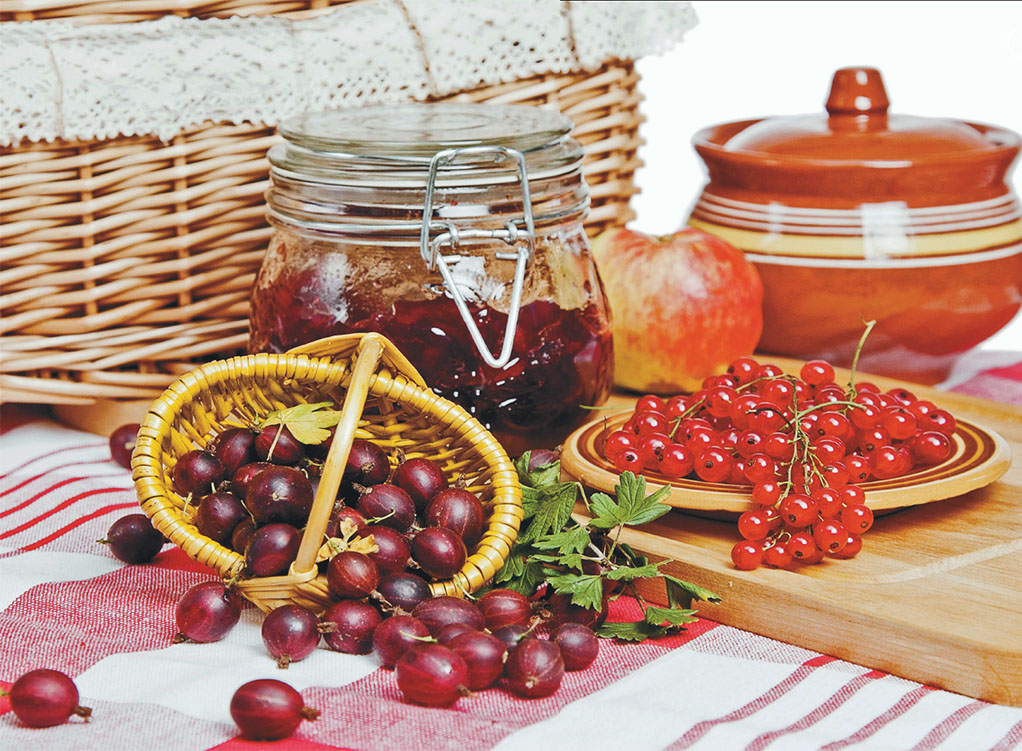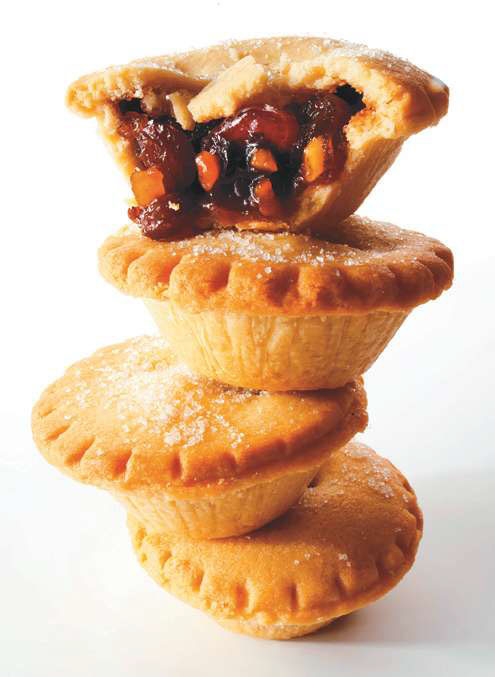
great british comestibles
[caption id="preserves_Feature" align="aligncenter" width="1022"]

ISTOCK VIA THINKSTOCK
Where would the Great British Cream Tea be without that dazzling dollop of jewel-like jam sparkling on top of a still-warm scone and a luscious slathering of clotted cream?
Brits have been finding ways to preserve summertime riches for the lean months since time immemorial. In its most basic forms—drying, salting, smoking, clamping (a method of keeping vegetables such as potatoes or carrots in mounds of earth and straw or trays of sand)—preserving worked, but it was hardly something for the average medieval peasant to actively look forward to. Experimentation and creativity, however, joined with necessity for far more appealing prospects.
[caption id="preserves_img1" align="alignleft" width="495"]

©FUNKY STOCK - PAUL WILLIAMS/ALAMY;
Pickling was brought to the British Isles by the Romans, but we have also culled recipes—sweet, sour, savory, plus concoctions of all three—from our travels. From the Crusades to the Raj we added them into our repertoire, and even had the gall to call them British.
The Holy Grail of preserves is homemade. National Trust tearooms often serve locally-made preserves, but the best way to find homemade for sale is to check for WI markets on your travels. The Women’s Institute has been holding markets, and selling through local fetes and fairs since 1915. Despite the rigors of recent EU health and safety regulations, many of the 210,000 WI members still regularly make delicious preserves for the rest of us to buy.
[caption id="preserves_img2" align="alignleft" width="495"]

©FOODFOLIO/ALAMY
Jam
Jams and jellies, usually fruit-based but with the odd delightful foray into vegetables, have been made for centuries. They only became really popular, though, when the price of sugar tumbled with the birth of West Indian plantations.
The heyday of jam and jelly making was the 19th century, and most English recipes have their origins in Victorian cookbooks. For clarity, jams tend to use the whole pulp, often seeds ‘n’ all; jellies are strained for a clear, more jewel-like preserve. A good jam will be full of fruit and firm to spread. Conserves are softer-set; “extra jam” will have a higher fruit-to-sugar ratio. Curds contain eggs and butter and are richer, but don’t keep as long. Everyone has a favorite. I love good old-fashioned strawberry, even though the low pectin levels make it a pig to set. My pal DT loves gooseberry, because he says it’s a truly “British” flavor. Our esteemed editor loves the dark richness of blackcurrant, and it is wonderful on crumpets with lots of butter. Some find it a little intense, in which case it’s worth trying the various blends available both commercially and on market stalls; rhubarb or apple are classic blackcurrant partners.
Marmalade
Although it will forever be associated with Scotland and oranges, the first Marmelos was a thick quince paste from Portugal. There’s a 19th-century yarn that James Keiller bought a cargo load of cheap, bitter oranges in Dundee, which his long-suffering wife used instead of quince, sparking a marmalade revolution. Sadly, though Keiller did make marmalade available commercially for the first time, recipes for “marmalet of oranges” date back to the 16th century.
True marmalade is made with bitter, Seville oranges, only available for a few short weeks in January and February. It’s down to personal taste whether you prefer it thick or thin-cut, but most agree that peel is an important part of the texture; the ones without bits are just wrong. I boil mine until the rind is very tender; my sister prefers a bit more bite, and most commercial marmalades side with her. You’ll occasionally find vintage marmalade matured for a denser flavor, “black” marmalade made with molasses, and souvenir versions with various whiskies added—but for my money the classic plain variety takes some beating. Traditionally, it’s smeared on toast, but I love it swirled in Greek yogurt.
Chutney
Nothing sums up the British magpie instinct for other people’s recipes more than chutney. Chatni is a Hindustani word for a strong, sweet relish, and in India few meals are served without it. During the British colonial era, fashionable cooks brought a little subcontinental magic home with them. Adapting the recipes to British ingredients was inevitable and the resulting hybrids remain ever-changing. In the middle of the 20th century, chutneys became bland, but modern tastes are reverting to sharper, spicier flavors to complement meat, cheeses and salads.
[caption id="preserves_img3" align="aligncenter" width="818"]

©KEITH LEIGHTON/ALAMY
Chutney is made by slowly boiling fruits, vegetables, sugar, spices and vinegar until they turn into a thick, jammy goo. But within that basic framework, anything goes. As long as you keep to the basic proportions, you can use whatever you have a glut of and whichever spices you enjoy. Last year, when all that rain meant my plot produced very little, I harvested whatever I could, weighed the lot and made a mongrel I called “allotment chutney.” Hardly an award-winner, but it tasted fine. Stores sell tried-and-tested recipes, but at village fetes and WI stalls you’ll find all sorts. I recommend you try the oddest one you see. Oh, and if you get a jar that’s only just been made, keep it at least a month. The longer you let it mature before opening the better it will taste.
Piccalilli
It’s turmeric that gives piccalilli that bright yellow glow, which reveals this is another recipe we can thank our Indian friends for. It’s quite old: although it’s not in Hannah Glasses’s 1747 classic The Art of Cookery Made Plain and Easy, by the reprint in 1755 she had added a recipe for Indian Pickle.
Similar to, but not as sweet as chutney, it’s also used for meats and cheeses, salads and sandwiches. Whereas chutneys and relishes can be almost translucent, piccalilli has an opaqueness to it, dotted with jewels of white, red and green from vegetables such as beans, cauliflower, silverskin onions, radish and red chilli. It sometimes has curry powder, sometimes mustard, sometimes cayenne pepper, and often all three. The cooking method is slightly different so that the vegetables retain a crunchier texture.
Mincemeat
Mincemeat’s ingredients can largely be traced back to crusaders returning from the Holy Land with exotic fruits and spices, dried for easy transportation. As the name suggests, it was originally made with meat, too. Medieval mince pies were oval to represent the manger, containing little pastry babies.
Oliver Cromwell outlawed Christmas; by the time it was restored, along with Charles II, mincemeat had changed. People had realized that if they topped up their dried fruits, nuts and spices with brandy or sack, it lasted for ages, and just kept getting better, thus starting a tradition for beginning the process a long way in advance to allow it to mature. Although beef was used in some mincemeats up to the early 20th century, the only animal product left in most modern recipes is suet, and even that is often replaced with vegetarian alternatives.
Green Bean Chutney
My mum bought a slender recipe pamphlet at a country show in the 1960s and she has been using and adapting this basic recipe ever since. Green, French, runner, most string beans are fine. Courgettes, broccoli—whatever you have a glut of—will also work.
2/b green beans, after trimming and slicing
1 ½ lb onions, chopped
1 heaped tablespoon corn starch
1 tablespoon turmeric
1 heaped tablespoon mustard powder
2/b soft brown sugar
1 ½ pints vinegar
Mix the dry ingredients to a small paste using some of the vinegar. Boil sliced beans in well-salted water until tender. Cook onions in ½ pint of the vinegar. Drain beans then add to the rest of the vinegar and cook for 10 minutes. Add the rest of the ingredients and boil for a further 15 minutes. Allow a few minutes to cool before jarring.
Mincemeats are generally uncooked, relying on alcohol to preserve them, but my favorite recipe is cooked and, I believe, worth the extra effort. As usual, the exact ingredients can be mixed and matched according to taste. If you’re buying, it’s worth going for good quality as commercial mincemeats are not created equal. Mincemeat is not just for Christmas, by the way. Coventry God-cakes, little triangular mincemeat puffs representing the Holy Trinity, were traditionally given to children by godparents at Easter or New Year.
Fancy adding some British preserves to your repertoire? I return again and again to Sara Paston Williams’ Good Old Fashioned Jams, Preserves and Chutneys, the WI Book of Preserves by Carol Tennant and Home Made Jams & Chutneys by Midge Thomas.





Comments